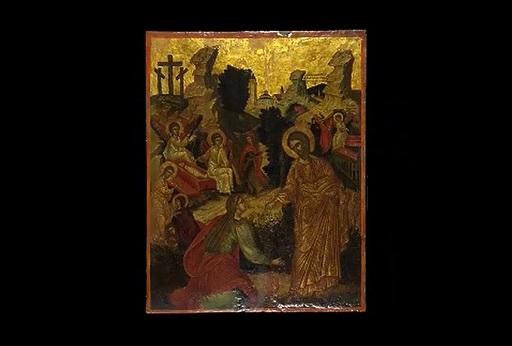1 ‘Reading’ an icon: Byzantine iconography and Gospel narrative
Watch the following video, in which Dr Angeliki Lymberopoulou examines a Cretan panel painting (icon), produced on the island during the period it was under Venetian rule, that copies the work of a famous Cretan master, Michael Damaskinos.
Watching the video closely will help you to consolidate the material explored in Week 1. In particular, the section between 4:53–9.45 analyses the relationship between iconography and Gospel narrative in some detail.

Transcript: Video 1 Open Arts Object: Noli me Tangere, Cretan Orthodox Icon, late 16th/early 17th century, British Museum, London.
The icon is organised in six successive levels, and accompanied by Greek inscriptions. For a detailed analysis, see Lymberopoulou, 2011, p. 189-194. In brief, the inscriptions on the icon and the relevant Gospel narratives are as follows:
First level:
The Noli Me Tangere (‘Touch Me Not’) is depicted. The scene is based on Saint John’s Gospel 20:17 ‘ΜΑΡΙΑ ΜΗ ΜΟΥ ΑΠΤΟΥ’ (‘Touch Me Not’).
Christ addresses Mary Magdalene, who is depicted kneeling to the left, ‘ΓΥΝΑΙ ΤΙ ΚΛΑΙΕΙΣ; ΤΙΝΑ ΖΗΤΕΙΣ’ (‘Woman why weepest thou? Whom seekest thou?’, John 20:15). In her turn, the Magdalene, before she recognizes Christ, asks him ‘ΚΥΡΙΕ ΕΙ ΣΥ ΕΒΑΣΤΑΣΑΣ ΑΥΤΟΝ, ΕΙΠΕ ΜΟΙ ΠΟΥ ΕΘΗΚΑΣ ΑΥΤΟΝ ΚΑΓΩ ΑΥΤΟΝ ΑΡΩ’ (‘Sir, if you have borne him hence, tell me where thou hast laid him, and I will take him away’, John 20:15). Once she realises that Christ is standing before her, she addresses him as ‘ΡΑΒΟΥΝΙ’ (‘Rabboni; which is to say, Master’, John 20:16).
Second level:
To the left, the scene of the ‘ΧΑΙΡΕ ΤΩΝ ΜΥΡΟΦΟΡΩΝ’ is depicted (‘All Hail to the Myrrhbearers’). This scene is named after the greeting Christ used to address the two Marys, depicted here to the right. According to Matthew’s Gospel 28:9, Christ met the two Marys (named as Mary Magdalene and the other Mary in Matthew 28:1) on their way back from Christ’s empty sepulchre, where they were informed by an angel that Christ had risen.
Third level:
To the left, the painter returns to John’s Gospel (20:11–13) to depict a scene which chronologically precedes the Touch Me Not episode: the recognisable figure of the Magdalene, with the rich hair and the red cloak, arrives at Christ’s Tomb – ‘ΜΑΡΙΑ ΔΕ ΕΙΣΤΗΚΕΙ ΠΡΟΣ ΤΩ ΜΝΗΝΕΙΩ ΚΛΑΙΟΥΣΑ ΕΞΩ’ (‘But Mary stood without at the sepulchre weeping’, John 20:11). Magdalene faces two angels, who are sitting on the tomb. One sits cross-legged, pointing with his right hand at the empty shroud clothes, while the second angel points also with his right hand upwards, to Heaven; the inscription reads: ‘ΚΑΙ ΛΕΓΟΥΣΙΝ ΑΥΤΗ ΕΚΕΙΝΟΙ ΓΥΝΑΙ ΤΙ ΚΛΑΙΕΙΣ’ (‘And they say unto her, Woman, why weepest thou?’, John 20:13).
Fourth level:
The three Marys, headed by the Magdalene, arrive at the tomb to anoint Jesus’ body with myrrh, where an angel informs them that Jesus has resurrected: ‘ΜΗΝ ΕΚΘΑΜΒΕΙΣΘΕ ΙΗΣΟΥΝ ΖΗΤΕΙΤΕ ΤΟΝ ΝΑΖΑΡΗΝΟΝ ΤΟΝ ΕΣΤΑΥΡΩΜΕΝΟΝ’ (‘Be not affrighted: Ye seek Jesus of Nazareth, which was crucified’, Mark 16:6). With his right hand he points at the empty tomb, on which he is sitting and he informs them: ‘ΙΔΕ Ο ΤΟΠΟΣ ΟΠΟΥ ΕΘΗΚΑΝ ΑΥΤΟΝ’ (‘behold the place where they laid him’, Mark 16:6).
Fifth level:
It shows the sepulchre with Christ’s empty clothes, mentioned in Luke’s Gospel (24:12).
Sixth level:
On the left side are the three crosses standing at Golgotha. Technical examination has uncovered traces that could be interpreted as a ladder leaning against the middle cross, alluding to the Deposition, as narrated in the Gospels of Mark 15:46 and Luke 23:53.
Between the two mountains ‘ΜΑΡΙΑ Η ΜΑΓΔΑΛΗΝΗΚΑΙ ΜΑΡΙΑ ΤΟΥ ΙΑΚΩΒΟΥ ΚΑΙ ΣΑΛΩΜΗ ΗΓΟΡΑΣΑΝ ΑΡΩΜΑΤΑ ΙΝΑ ΕΛΘΟΥΣΑΙ ΑΛΕΙΨΩΣΙΝ ΑΥΤΟΝ’ (‘Mary Magdalene, and Mary the mother of James and Salome, had bought sweet spices, that they might come and anoint him’, Mark 16:1; technical analysis of the icon has revealed that this is a later addition, which nevertheless draws from the Gospel narrative).
